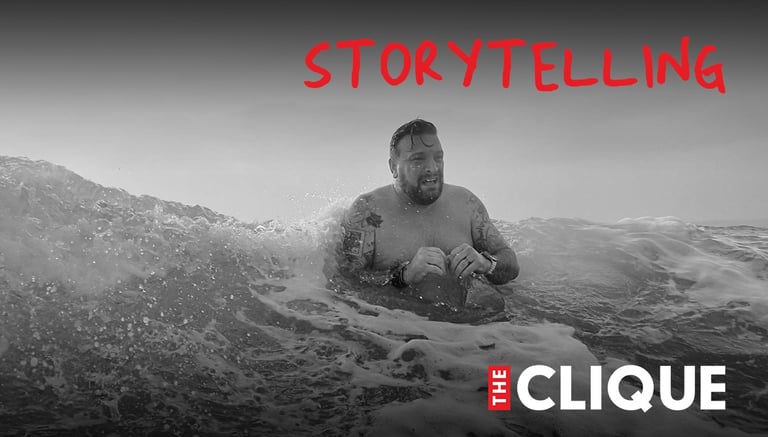The Narrative Advantage


// Introduction
Stories are more than just words - they're powerful tools that can transform your brand and captivate your audience. The world is built on stories, from religion to world wars, every action and every interaction creates a narrative and whilst you may think that your world is bland and boring, everyone has a story to tell.
Sharing personal stories can make your brand more relatable and memorable, creating a lasting impact on your following - it brings people along on your journeys.
I’ve lost count of the times that someone has said to me that they think I have an interesting life and that they wish they could experience half the things that I do but to me, everyone has an interesting life and I wish I had theirs.
You see, the grass isn’t always greener on the other side and quite often, we suffer and restrict ourselves through comparison.
// Impact
The thing about telling stories and weaving in a personal narrative is that you don’t sound like anyone else because no-one else has your lived experiences.
Each story is a tapestry woven from the threads of your unique journey – the challenges you’ve faced, the triumphs you’ve celebrated, and the goals you aspire to achieve. This authentic narrative distinguishes you from the crowd, offering a voice and a perspective that are unmistakably yours.
It makes your brand more than just a business.
The depth that people feel because of how they resonate with what you’re looking to achieve cannot be replicated through standard marketing and when people see your story (yes, I know - I said ‘see’ your story) they will feel a part of it.
A story will transform your words into vivid experiences that captivate and resonate. Through storytelling, you invite your audience into your world, sharing not just your wins and losses but also your dreams and the values that drive you. This creates a rich, multi-dimensional connection that goes far beyond traditional communication methods.
Again, It makes your brand more than just a business.
It becomes a living entity with a soul, one that people can relate to on a personal level. Your story humanizes your brand, allowing it to connect deeply with customers, who start to see it as an extension of themselves or as a companion in their own journey.
The depth that people feel because of how they resonate with what you’re looking to achieve cannot be replicated through standard marketing. When you tell your story, it’s not just about presenting facts or figures – it’s about creating an emotional landscape that your audience can navigate. They see your struggles, feel your passions, and celebrate your successes as if they were their own. This shared experience fosters a sense of belonging and loyalty that is invaluable.
When people see your story – yes, I know, I said ‘see’ your story – they will feel a part of it. Stories are visual and visceral. They paint pictures in the minds of your audience, allowing them to visualize your journey and imagine themselves within it. (I can almost see you now, imagining that there is a paint easel and colours being painted onto a canvas)
It’s about making your audience not just hear your message but experience it, live it, and feel it in a way that is both personal and profound.
Now, some of you might be slightly uncomfortable with telling stories, it can one step too far and you might feel like you’re taking a step back to the early years of Facebook (remember when we used to update everyone with where we were) but let me explain this a little further.
Storytelling isn’t sharing everything and making your audience experience everything in your world - thats just plain crazy.
The reason being is that not every story will resonate, you have to choose carefully what stories to share because they need to align with your values and highlight pivotal moments along your journey.
Imagine that as we go through life, we leave a trail of cloud behind us - within that cloud is every story, every memory and every moment and it’s your job to reach into that cloud, pull out a narrative and weave that into your marketing.
This takes practice and takes a lot of skill to be able to weave a something with meaning and slowly, every time you reach into that story cloud, you’ll learn what resonates and what doesn’t.
You’ll learn where the line is between sharing and oversharing and you’ll be able to refine your skillset when it comes to mastering the art of storytelling.
You don’t have to hold back either - you can go for it, go all in, share as much as you like and see how that works. If you’re someone who absolutely loves to post on Facebook and give the world an update then go for it - it’s just not a space I occupy.
I used to share prolifically on Facebook (as I’m sure we all did) - now, Mark Zuckerberg will be lucky if I log in once a month, it’s literally only there because I share the odd photo (24th May was the last photo I shared).
You can adjust, you can try different things and you can tailor what you share to the platform you’re sharing on.
// Weaving
As I mentioned earlier, weaving a strong story into your marketing is crucial because it breathes life into your messaging. A story with soul is what transforms ordinary content into something that resonates deeply with your audience. Every great story follows a structure – a beginning, a middle, and an end – and it must be relevant to your audience to truly captivate them.
To create compelling stories, you need a clear narrative arc that keeps your audience engaged and emotionally invested. This means structuring your story in a way that is coherent and meaningful, guiding your audience through a journey where each part connects seamlessly to the next.
What do I mean by this?
Imagine if I were to tell you a story about how I joined the Army, then suddenly veer off into a tangent about how I learned to ride a bike, and then describe what I had for lunch today. While each of these anecdotes might be interesting on their own, together they form a disjointed narrative that doesn’t connect or resonate with the current context or audience. They lack the common thread that binds them into a cohesive story relevant to what we're discussing.
Now think about this: If I instead weave a tale about starting my newsletter, explaining how I discovered the way storytelling engaged my audience and then concluded with a reflection on how this very article exemplifies what I've learned – then I've created a narrative arc. This story not only aligns with the topic at hand but also demonstrates growth and insight in a relatable way.
It draws the audience in, making them a part of the journey, and providing them with a valuable takeaway.
Every story you tell should showcase how your experiences have shaped your brand and your approach to business. Your audience wants to see the journey behind your successes and challenges. They’re interested in understanding the “why” behind your actions and decisions.
This is where your story becomes a powerful tool – by sharing the personal moments that have influenced your path, you allow your audience to connect with you on a deeper level.
If your story also gives your audience a glimpse into your soul, all the better because people are drawn to authenticity and vulnerability.
When you let your guard down and share your true self, you create a bond that is hard to break. Your audience begins to see your brand not just as a business, but as a reflection of your values, passions, and aspirations. This transparency fosters trust and loyalty, making your message not only heard but felt.
In summary, the stories you tell are the heartbeat of your brand.
They transform data into emotion, facts into experiences, and transactions into relationships.
By crafting your narrative with care and intention, you not only capture attention but also build lasting connections with those who matter most.


